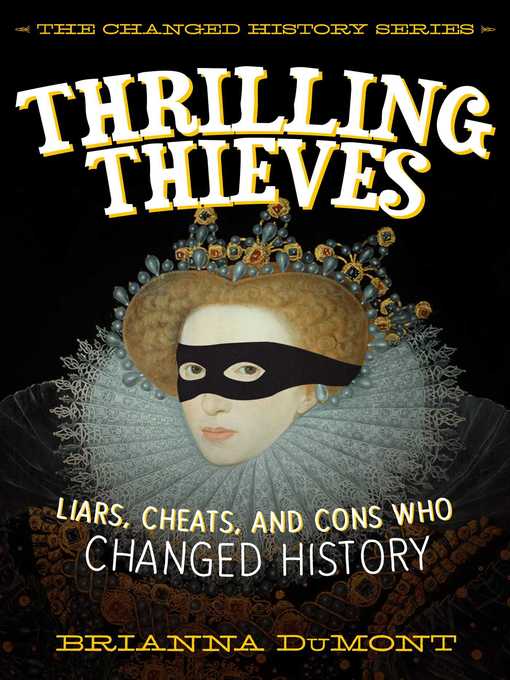
Thrilling Thieves
Thrilling Thieves: Liars, Cheats, and Cons Who Changed History
فرمت کتاب
ebook
تاریخ انتشار
2018
Lexile Score
1020
Reading Level
6-8
ATOS
7.4
Interest Level
4-8(MG)
نویسنده
Brianna DuMontناشر
Sky Ponyشابک
9781510701724
کتاب های مرتبط
- اطلاعات
- نقد و بررسی
- دیدگاه کاربران
نقد و بررسی

June 1, 2018
Gr 5-8-The latest installment in the series is a well-organized collection of minibiographies of historical figures who stole their way into history books, from Elizabeth I and Thomas Edison to Robert Gardner and Madame Cheng. Overall, the text is easy to read. Even students who dislike history will find DuMont's style engaging rather than dry. Chapters are not lengthy and do not go into great detail, but they manage to explain exactly why a specific person fits into the theme. In many instances, the content offers opportunities for discussion about whether or not the term thief, liar, con, or cheat really applies to a subject, such as Robert Smalls, who escaped slavery by stealing a Confederate ship to get himself, his family, and others who were enslaved to freedom. Terminology specific to the era or further elaborations on the vocabulary is highlighted in text boxes alongside paragraphs. The author also includes her sources for students who may wish to do more in-depth reading. VERDICT A solid purchase for collections where nonfiction anthologies, like Georgia Bragg's How They Croaked, are popular.-Paige Garrison, The Davis Academy, Sandy Springs, GA
Copyright 2018 School Library Journal, LLC Used with permission.

June 1, 2018
Thieves of the highest magnitude--think Napoleon--get a good tattling from DuMont in a continuation of her Changed History series.These are thieves who really did change history by moving the stolen items around the globe, sometimes in a small span, around Paris, for example, and sometimes from one continent to another. DuMont starts with the Venetians, who not only stole St. Mark's body, but made alarming gains during the Crusades. She moves on to Francisco Pizarro and his conveyor belt of gold and silver from the Incan Empire to Spain. It took Francis Drake six days to empty one of King Philip's Spanish treasure ships of its gold and silver. That is the same Drake to whom Queen Elizabeth gave "more ships to cram more Africans aboard to sell in the West Indies." DuMont can come off as glib, but for the most part she is just throwing sauce in the face of egregious greed. There is also one heroic con man: Robert Smalls, an African-American pilot who ran the Confederate blockade of Charleston to take freedom for himself and a good number of slaves. DuMont also names secondary characters, which is particularly satisfying, as in introducing Vivant Denon, Napoleon's choice to direct his growing art hoard and inventor of the modern museum.A sassy, historically sound visit with some of the more (mostly) rudely audacious characters who have taken what wasn't theirs. (Nonfiction. 11-16)
COPYRIGHT(2018) Kirkus Reviews, ALL RIGHTS RESERVED.

July 1, 2018
Grades 4-8 Just as she did in Fantastic Fugitives (2016), DuMont offers another exciting look at criminals?this time, thieves?throughout history. Beginning with the Venetians, she continues chronologically with 11 individuals, including Chinese pirate Madame Cheng, Thomas Edison, and spy Klaus Fuchs. In a conversational style, emphasized by over-the-top humor, each profile relates the time period, the thief's conquest, and the thievery's impact on history. For instance, when Vincenzo Peruggia stole the Mona Lisa from the Louvre in 1911, the painting was only a B-list celebrity. Its incredible return years later made it the star it is today?and, of course, influenced art museum security around the world. (Its first thief, Napoleon, is also featured in the book.) The term thief is used loosely with other individuals, such as Englishman Robert Fortune, who stole the tea trade from China in the 1800s and gave it to British-controlled India. And helping to steal the show in this rousing read are funny cartoons, period photos, reproductions, and interesting sidebars. Even reluctant nonfiction readers will become history buffs.(Reprinted with permission of Booklist, copyright 2018, American Library Association.)

























دیدگاه کاربران